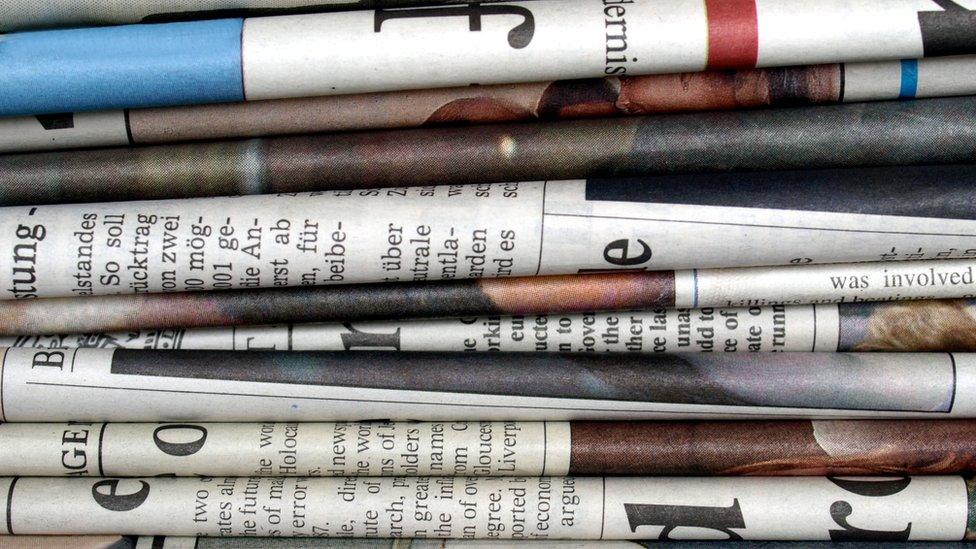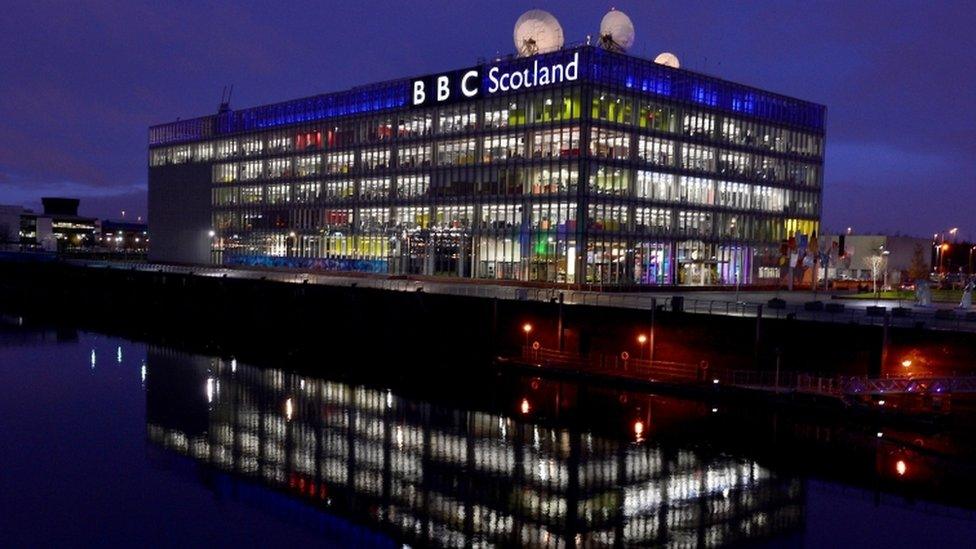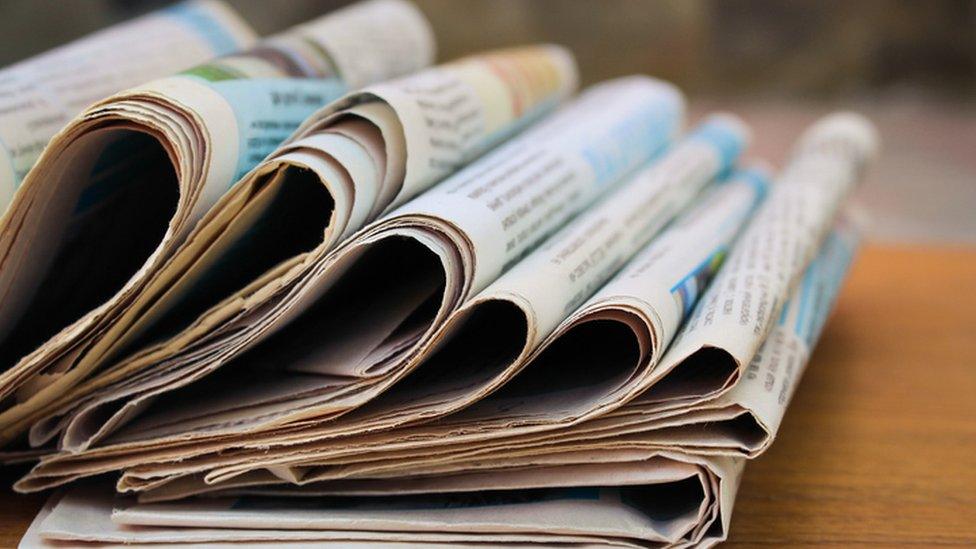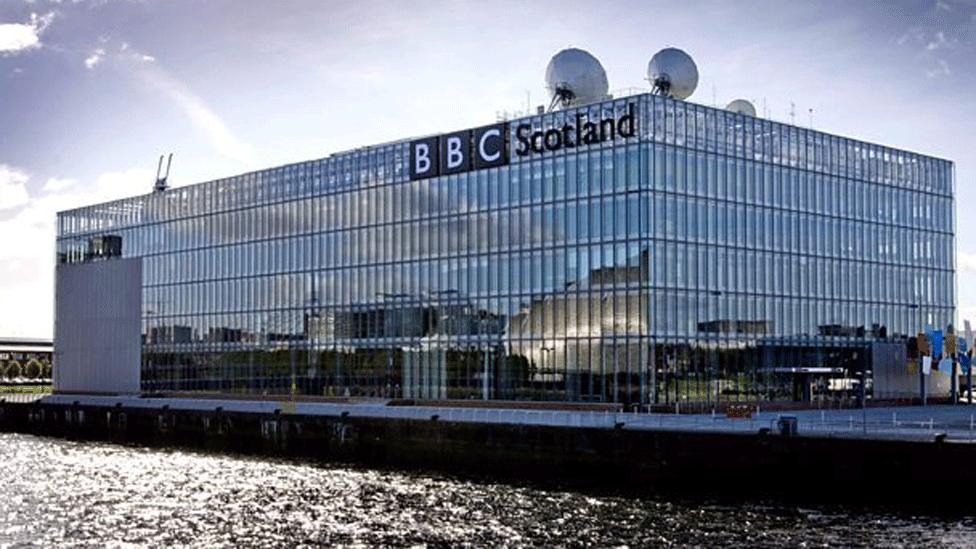The news news: breaking, making or faking it?
- Published

"Navel-gazing - readers don't care": with that, coverage of and by the news media tends to be dismissed from editorial conference meetings.
Newspapers used to take a chunk of page two for the editor to trumpet the (sometimes selective use of) circulation figures, and "how much better we've been selling than our down-market, parochial rival rag" - or similar.
You don't see that so much now, because none of the sales figures are to be trumpeted.
Newspapers remain an important pillar of Scottish life, politics, culture and identity. The four city-based titles are all more than 200 years old - The Scotsman and Courier reaching that milestone in the past year.
They don't do much to report on themselves. Yet there's rarely been so much interest and discussion of news and how it is reported.
The constitutional debates about Scotland and Brexit excite theories of newspaper conspiracy, and over-powerful proprietors.
Social media has given access to everyone, on an equal basis, to have their say, where many are contemptuous or dismissive of "the MSM" (mainstream media) or "dead tree press".
One such conspiracy theorist has taken up residence in the White House, and is using that "bully pulpit" to trash the big news brands. Fake news, he says. Fake. Sad. His people have "alternative facts". There may be lessons there for us all. More of President Trump later.
Across the channel
Close to home turf for me, this week brought an unusual sensation. For the first time in 28 years as a journalist, I'm working for an organisation that has ambitious plans for significant expansion.
A digital TV channel for Scotland, including an hour-long news programme, viewing Scotland, the UK and the world from a Scottish studio, is an exciting prospect.
To have spent nearly three decades inside an industry in gradual and then more rapid decline, facing cuts, job losses and narrowing ambitions, takes its toll. It's more difficult to be creative and bold in that environment, or to take risks.
So this could change. It brings 80 more journalists at the BBC, and the opportunity to try new approaches to news.
To its credit, STV has got to a similar plan, and earlier. If there's one thing we envy of our broadcast rivals just along the south bank of the Clyde, it's the ability to take decisions quickly.
It is doing so by taking the city TV licences for Glasgow and Edinburgh, adding Dundee, Aberdeen and Ayr later this year, and making a sort of national network. That may somewhat undermine the intended spirit of local TV, but it's an innovative response in a changing market.

Plans for a BBC Scotland channel were announced by director-general Tony Hall
The newspapers gave the BBC's initiative far more coverage than their own part of the industry. Broadcasters fill a lot of column inches, from plundering political interviews to personal dramas about soap opera stars, generating a steady flow of on-screen celebrity.
It was down to the BBC, and to the media trade press and websites, to report the full-year sales figures for so-called 'regional' newspapers, which were published this week by the industry's audit organisation.
They were all down. The National led the charge, falling 30% to 8,500 daily sales. That somewhat undermines the arguments that other papers are suffering the consequence of being out of kilter with the political zeitgeist. Political slant doesn't matter half as much as political people think.
The National may yet be viable, because it has the back office management, advertising sales and printing capacity of the Herald and Evening Times group.
The National can pursue its strongly pro-independence agenda with very few resources; a small number of young journalists, a very imaginative graphic designer, and its in-house Wee Ginger Dug.
Fit to print
More worrying is the plight of The Scotsman. Sales were down 14% to below 20,000. More than 2,000 of them are given away for free.
The daily provides the infrastructure for Scotland on Sunday, which saw sales down 26% on the second half of 2015. The Edinburgh Evening News, also in that group, was down 16% to 18,400 - more than the other three city "evening" titles. (They're not really evening papers now, so much as local. Almost all their content is in place before that day's morning titles.)
Many of these titles attract much bigger audiences for their online news, which is free to access. But few offer reliable, audited figures. The Scotsman's number is just under 100,000 visitors per day: The Herald at 88,000.
No-one is getting rich from the advertising that comes with online news. There's recent evidence that, for all its falling sales, print still gets much more time than the written word on screen, and advertisers pay heed to such evidence.
Saturday sales illustrate that. Even at much higher prices, many titles see their print sales lift at the weekend. The Guardian sells around 8,000 on the average weekday in Scotland, but that nearly doubles on Saturday. Many people seem to prefer a paper to a computer screen when they're kicking back over brunch.
Indebted Scotsman
The Scotsman group is burdened with its proprietor's enormous debts. Johnston Press, also based in Edinburgh, is under siege from an activist investor, now with a 20% stake, which seems to have lost faith in the JP management and strategy.
That strategy is to invest in its new acquisition of the 'i' low-price quick read, which grew out of The Independent. It gives Johnston a UK-wide reach for advertising.
The group has had to sell some of its 200-plus local titles, including those in Ireland, the Isle of Man and East Anglia. More are on the sales block, though it seems Johnston want to retain The Scotsman as its best-known brand.
Industry insiders say DC Thompson, owner of The Courier, Press & Journal and Sunday Post, would be interested in taking on The Scotsman stable, at the right price.
The Dundee family firm has shown a knack for adapting in this exceptionally difficult market, by staying close to readers. But Johnston Press seems determined to soldier on as things are. It may be that the going price for The Scotsman falls far short of what its creditors require.
News bundled
This has been good news for The Times, which is picking off chunks of the Edinburgh region up-market readership. Its editor, Magnus Llewellin, attributes that to investment in journalism. It has been poaching some of the more experienced writers in Scottish news and sport, including Mr Llewellin himself, formerly editor of The Herald.
Beyond that, it has been much smarter than others at bundling print sales with subscriptions. It has sent the message that if you want quality news, you should pay for it, starting with teaser subscriptions rates.
It helps that the Times website is a coherent fit with the print product. Too many other papers want to draw readers across to their online journalism, only to find that it looks and feels very different. That can undermine the brand.
The Times' subscription approach takes time and deep pockets. The title's ultimate boss, Rupert Murdoch, did something similar with Sky television. It's worked, and squeezed out rivals, from BSB to Setanta.
Citizen journalism
All this is with the backdrop of conventional news sources being trusted less. As with other institutional pillars, there's a desire to kick over the old order, and replace it with... well, what?
Citizen journalism? Websites driven from a political conviction, and crowd-funded? The cacophony of social media? Getting attention by being outrageous? Endlessly challenging the mainstream media to be more accountable?
That is where Donald Trump is dragging the debate in the USA. The industry there is much more given to navel-gazing. It has been asking whether it covered the Trump campaign phenomenon as it should, and how it now covers the presidency.
If every unwelcome news report is to be challenged, or denounced as fake news, and if the mis-statements and hypocrisy of Mr President simply meet with a shrug, how should they cover the White House?
(And having seen some of these 'trash-the-messenger' tactics used in two referendums on this side of the Pond, how would a further Scottish referendum be reported any differently from last time?)
Today, the question is how you report the president when the awkward squad of mainstream news outlets - including the BBC - is excluded from briefings.
I'm reminded of a friend who was a White House correspondent in the early 1970s. He was blacklisted by President Richard Nixon when he wrote that he had been given an ashtray with the presidential seal on it, which he was using as a water bowl for his dog.
One answer to being excluded, I'd humbly suggest, is: wear it with pride. Don't play their game. If you're not being excluded by the Trump White House, ask what you're doing wrong. You can do your job with the information that's publicly available.
In any case, what would you miss? Do we really think that the huddles of journalists around the spokesman are going to be any more newsworthy or revelatory than President Trump's attention-hungry, headline-grabbing government-by-tragi-comedy-Tweet/stump speech/monologue?
- Published24 February 2017

- Published24 February 2017

- Published22 February 2017
